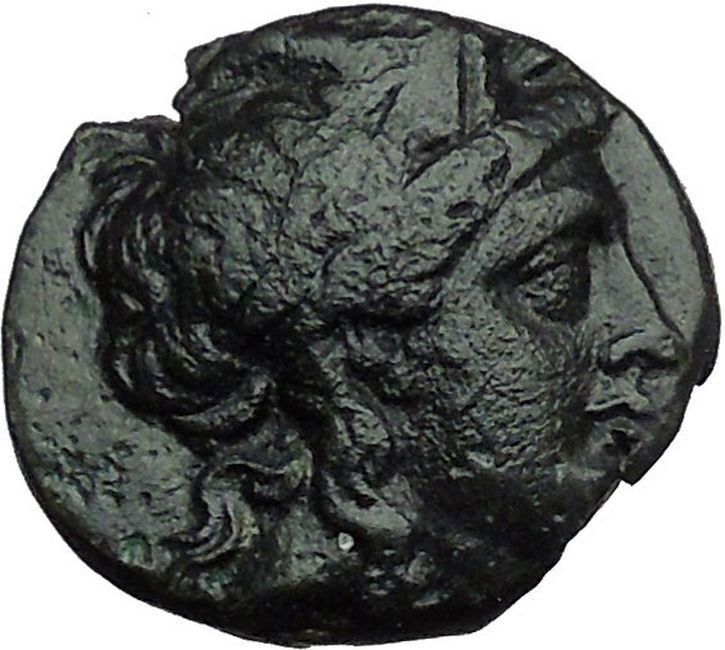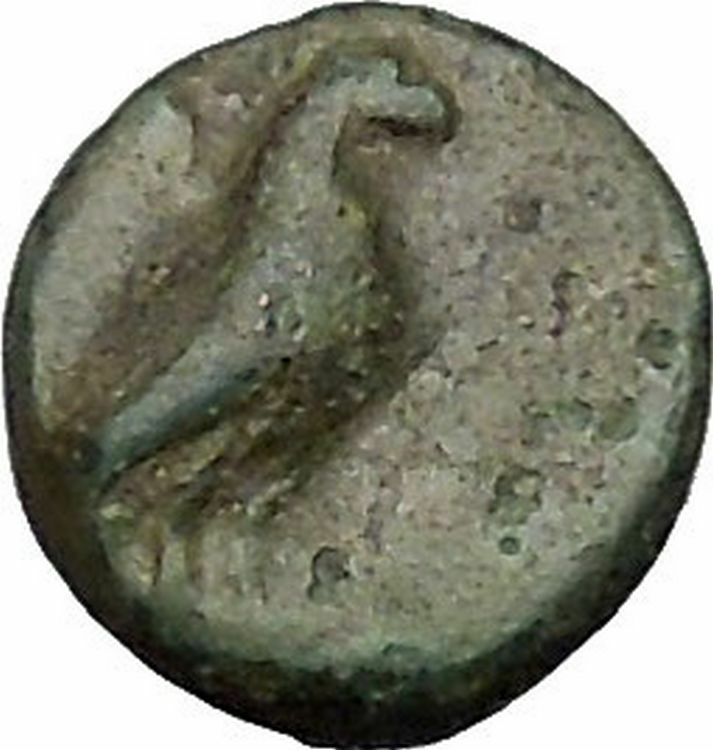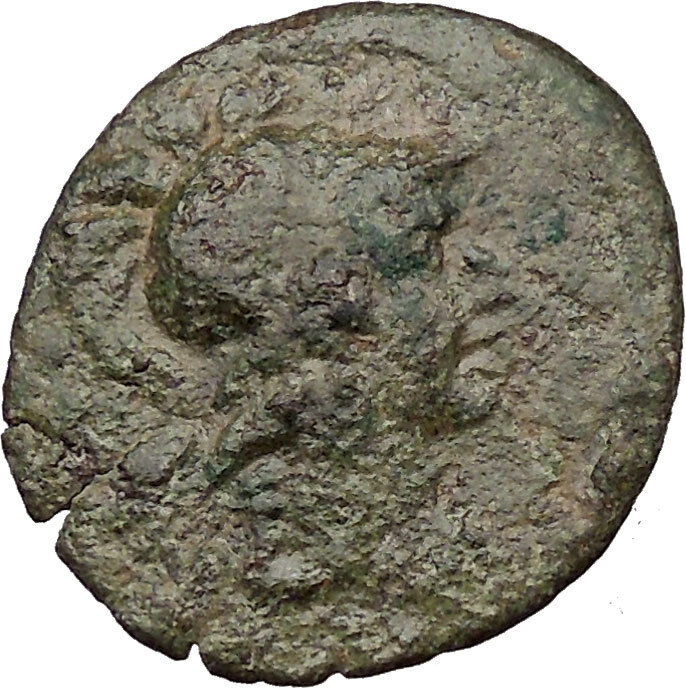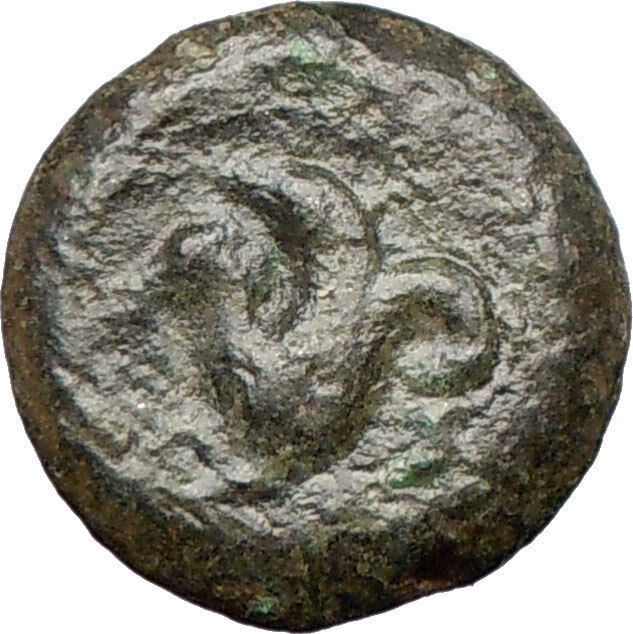|
Greek Coin of Seleukid Kingdom
Antiochos VII Sidetes – King: 138-129 B.C.
Bronze 14mm (2.69 grams) Antioch on the Orontes mint, struck circa 138-129 B.C.
Reference: HGC 9, 1096; Sear 7100
Nemean lion’s head right.
Club of Hercules; on right, ΒΑΣΙΛΕΩΣ / ANTIOXOY; on left, EYEPΓETOY.
Almost alone amongst the later Seleukid monarchs, Antiochos VII ruled with competence and integrity. He was the younger brother of Demetrios II, and following the latter’s capture by the Parthians he seized power and quickly disposed the usurper Tryphon. He campaigned with success in Palestine and Babylonia, but in 129 B.C. he was killed in battle against the Parthians.
You are bidding on the exact item pictured, provided with a Certificate of Authenticity and Lifetime Guarantee of Authenticity.
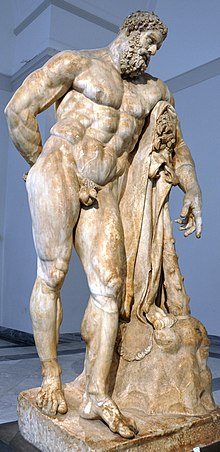 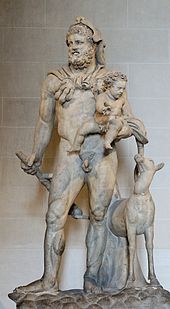 Heracles, born Alcaeus (Alkaios) or Alcides, was a divine hero in Greek mythology, the son of Zeus and Alcmene, foster son of Amphitryon and great-grandson and half-brother (as they are both sired by the god Zeus) of Perseus. He was the greatest of the Greek heroes, a paragon of masculinity, the ancestor of royal clans who claimed to be Heracleidae and a champion of the Olympian order against chthonic monsters. In Rome and the modern West, he is known as Hercules, with whom the later Roman emperors, in particular Commodus and Maximian, often identified themselves. The Romans adopted the Greek version of his life and works essentially unchanged, but added anecdotal detail of their own, some of it linking the hero with the geography of the Central Mediterranean. Details of his cult were adapted to Rome as well. Heracles, born Alcaeus (Alkaios) or Alcides, was a divine hero in Greek mythology, the son of Zeus and Alcmene, foster son of Amphitryon and great-grandson and half-brother (as they are both sired by the god Zeus) of Perseus. He was the greatest of the Greek heroes, a paragon of masculinity, the ancestor of royal clans who claimed to be Heracleidae and a champion of the Olympian order against chthonic monsters. In Rome and the modern West, he is known as Hercules, with whom the later Roman emperors, in particular Commodus and Maximian, often identified themselves. The Romans adopted the Greek version of his life and works essentially unchanged, but added anecdotal detail of their own, some of it linking the hero with the geography of the Central Mediterranean. Details of his cult were adapted to Rome as well.
Extraordinary strength, courage, ingenuity, and sexual prowess with both males and females were among the characteristics commonly attributed to him. Heracles used his wits on several occasions when his strength did not suffice, such as when laboring for the king Augeas of Elis, wrestling the giant Antaeus, or tricking Atlas into taking the sky back onto his shoulders. Together with Hermes he was the patron and protector of gymnasia and palaestrae. His iconographic attributes are the lion skin and the club. These qualities did not prevent him from being regarded as a playful figure who used games to relax from his labors and played a great deal with children. By conquering dangerous archaic forces he is said to have “made the world safe for mankind” and to be its benefactor. Heracles was an extremely passionate and emotional individual, capable of doing both great deeds for his friends (such as wrestling with Thanatos on behalf of Prince Admetus, who had regaled Heracles with his hospitality, or restoring his friend Tyndareus to the throne of Sparta after he was overthrown) and being a terrible enemy who would wreak horrible vengeance on those who crossed him, as Augeas, Neleus and Laomedon all found out to their cost.
Antiochus VII Euergetes, nicknamed Sidetes (from Side), ruler of the Hellenistic Seleucid Empire, reigned from 138 to 129 BC. He was the last Seleucid king of any stature.
Biography
He was one of the sons of Demetrius I Soter, the brother of Demetrius II Nicator and his mother may have been Laodice V. Antiochus was elevated after Demetrius’ capture by the Parthians. He married Cleopatra Thea, who had been the wife of Demetrius. Their offspring was Antiochus IX, who thus became both half-brother and cousin to Seleucus V and Antiochus VIII.
Sidetes defeated the usurper Tryphon at Dora and laid siege to Jerusalem in 132. During the siege he allowed a seven day truce for the Jews to celebrate a religious festival, impressing the Jewish leadership. According to Josephus the Hasmonean leader John Hyrcanus opened King David‘s sepulchre and removed three thousand talents, which he then paid Antiochus to spare the city. Nevertheless, King Antiochus’ respectful treatment of the Jews, and respect for their religion, earned him their gratitude and added name, Euergetes (“the Benefactor”). With no Jewish sources of that time (the Book of Maccabees ends few years before his time) it is unclear if the siege on Jerusalem ended with a decisive Seleucid victory or simply a peace treaty. Furthermore, the fact is that Jewish forces later assisted Sidetes in his wars, and that for nearly 20 years after his death, John Hyrcanus refrained of attacking areas under Seleucid control. All in all it indicates a renewal of the friendly relations from the time of Demetrius II.
Antiochus spent the final years of his life attempting to reclaim the lost eastern territories, overrun by the Parthians under their “Great King”, Mithridates I. Marching east, with what would prove to be the last great Seleucid royal army (including a unit of Judean troops under John Hyrcanus), he defeated Mithridates in two battles, killing the aged Parthian king in the last of these. He restored Mesopotamia, Babylonia and Media to the Seleucid empire, before dispersing his army into winter quarters.
The Seleucid king and army spent the winter feasting, hunting, and drinking (the Seleucids maintained the Macedonian tradition of heavy drinking). As with any time an army is quartered upon a population, tensions soon grew between the locals and the Seleukian troops.
The new Parthian ruler, Phraates II, had not been idle; raising a new army while stirring up rebellion in the Seleucid occupied towns of Media. Hoping to further sew dissension amongst his foe, Phraates also released his long-held prisoner, Demetrius II, Antiochus’ older brother, to return to Seleukia and reclaim the throne.
That winter (130–129 BCE), several Median towns rose in rebellion and attacked their Seleucid garrisons. Antiochus marched to support one such isolated garrison with only a small force (likely only his Royal Guards). In a barren valley, he was ambushed and killed by Phraates II and a large force of Parthians, which had entered the country without being detected. The last great Seleucid king died in battle, a fitting end for the heir of Seleucus I Nicator (the Victor). (One disputed account has Antiochus take his own life, after the battle is lost, to avoid capture by the Parthians.)
After Antiochus VII Sidetes, the Parthians regained the territory briefly lost, and the Seleucid realm was now restricted to Seleukia.
Seleucid Empire
Σελεύκεια
Seleúkeia |

|
312 BC–63 BC |
↓ |
|
|
The Seleucid Empire in 301 BC.
|
The Seleucid Empire was a Hellenistic state ruled by the Seleucid dynasty founded by Seleucus I Nicator following the division of the empire created by Alexander the Great. Seleucus received Babylonia and, from there, expanded his dominions to include much of Alexander’s near eastern territories. At the height of its power, it included central Anatolia, the Levant, Mesopotamia, Kuwait, Persia, Afghanistan, Turkmenistan, and northwest parts of India.
The Seleucid Empire was a major center of Hellenistic culture that maintained the preeminence of Greek customs where a Greek-Macedonian political elite dominated, mostly in the urban areas. The Greek population of the cities who formed the dominant elite were reinforced by emigration from Greece. Seleucid expansion into Anatolia and Greece was abruptly halted after decisive defeats at the hands of the Roman army. Their attempts to defeat their old enemy Ptolemaic Egypt were frustrated by Roman demands. Much of the eastern part of the empire was conquered by the Parthians under Mithridates I of Parthia in the mid-2nd century BC, yet the Seleucid kings continued to rule a rump state from the Seleukid Kingdom until the invasion by Armenian king Tigranes the Great and their ultimate overthrow by the Roman general Pompey.
|






 Heracles, born Alcaeus (Alkaios) or Alcides, was a divine hero in Greek mythology, the son of Zeus and Alcmene, foster son of Amphitryon and great-grandson and half-brother (as they are both sired by the god Zeus) of Perseus. He was the greatest of the Greek heroes, a paragon of masculinity, the ancestor of royal clans who claimed to be Heracleidae and a champion of the Olympian order against chthonic monsters. In Rome and the modern West, he is known as Hercules, with whom the later Roman emperors, in particular Commodus and Maximian, often identified themselves. The Romans adopted the Greek version of his life and works essentially unchanged, but added anecdotal detail of their own, some of it linking the hero with the geography of the Central Mediterranean. Details of his cult were adapted to Rome as well.
Heracles, born Alcaeus (Alkaios) or Alcides, was a divine hero in Greek mythology, the son of Zeus and Alcmene, foster son of Amphitryon and great-grandson and half-brother (as they are both sired by the god Zeus) of Perseus. He was the greatest of the Greek heroes, a paragon of masculinity, the ancestor of royal clans who claimed to be Heracleidae and a champion of the Olympian order against chthonic monsters. In Rome and the modern West, he is known as Hercules, with whom the later Roman emperors, in particular Commodus and Maximian, often identified themselves. The Romans adopted the Greek version of his life and works essentially unchanged, but added anecdotal detail of their own, some of it linking the hero with the geography of the Central Mediterranean. Details of his cult were adapted to Rome as well.


